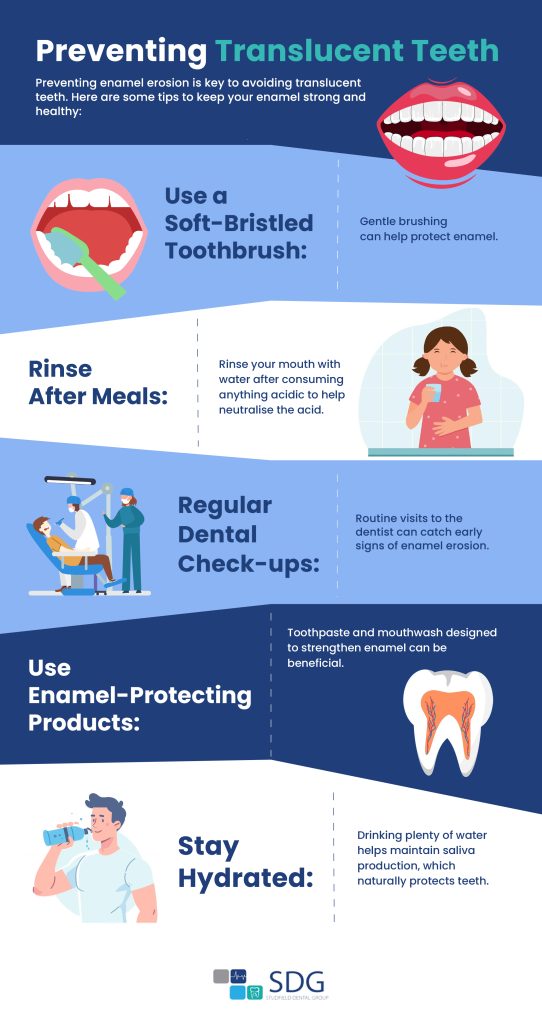Translucent Teeth: Causes and Treatments in Wantirna

Have you ever noticed that your teeth look a bit see-through at the edges? Or maybe you’ve seen someone else with this issue and wondered what’s going on.! Translucent teeth are more common than you might think. But what exactly causes this, and what can you do about it? Keep reading to find out.
What Are Translucent Teeth?
Translucent teeth are exactly what they sound like; teeth that appear semi-transparent, especially at the edges. Instead of a solid, opaque appearance, the edges of your teeth might seem almost glass-like. While this can be a cosmetic concern for many people, it can also hint at underlying dental issues that might need attention.
What Causes Translucent Teeth?
Several factors can contribute to the translucent appearance of teeth. Here are some of the most common causes:
1. Enamel Erosion
The outer layer of your teeth is made of enamel, which is the hardest substance in your body. However, enamel loss is permanent and can wear away due to various factors, including:
- Acidic Food and Drinks: Consuming a lot of citrus fruits, sodas, coffee, candy or other acidic food can erode enamel over time.
- Brushing Too Hard: Brushing your teeth too frequently and aggressively can wear down enamel.
- Acid Reflux: Stomach acid that comes up into the mouth can erode enamel. Those suffering from gastroesophageal reflux disease (GERD) may regurgitate stomach acid often leading to enamel damage.
- Bulimia: Frequent vomiting associated with eating disorders can expose teeth to stomach acid.
2. Genetics
Sometimes, translucent teeth can be a result of genetic conditions like Enamel Hypoplasia or Amelogenesis Imperfecta, which affects the development of enamel. Enamel Hypoplasia refers to tooth enamel that’s not formed correctly which leaves portions of your teeth with very thin or absent enamel. Amelogenesis imperfecta is a malfunction of the proteins in the enamel.
3. Celiac Disease
Celiac disease is an autoimmune disease characterised by the intolerance of gluten present in wheat, barley and rye. This can affect the development of enamel, leading to defects that might include a translucent appearance.
4. Mineral Deficiency
A lack of essential minerals like calcium and vitamin D can weaken enamel, making teeth more susceptible to becoming translucent.
5. Dry Mouth
Saliva acts as a buffer between your teeth, removing plaque and acid from them. Your teeth may appear more translucent when this saliva is absent. This is because dry mouth causes enamel degradation.
6. Aging
Enamel can degrade naturally with age as the enamel tends to become thinner with time, making it prone to decay.
How to Treat Translucent Teeth
So what can be done in this situation? The good news is that there are several ways to address translucent teeth, depending on the underlying cause. Here are some treatment options:
1. Fluoride Treatments
Fluoride can help strengthen enamel and is often used in both professional treatments and over-the-counter products. Your dentist might recommend fluoride varnish or fluoride toothpaste to help rebuild enamel.
2. Dental Bonding
For more immediate cosmetic improvement, dental bonding can be a great option. This involves applying a tooth-coloured resin to the affected areas, which is then hardened with a special light to bond it to the tooth.
3. Veneers
If the translucency is more severe, veneers might be the way to go. Veneers are thin shells of porcelain or composite resin that cover the front surface of the teeth, providing a more opaque and uniform appearance.
4. Crowns
Having translucent teeth that are weak and chipping will make you a candidate for crowns. Dental crowns are placed on top of the natural tooth to protect them from further damage and to provide structure.
5. Dietary Changes
Reducing your intake of acidic foods and drinks can help prevent further enamel erosion. Additionally, ensuring you get enough minerals through your diet or supplements can support overall dental health.
6. Addressing Medical Conditions
If an underlying condition like celiac disease or acid reflux is causing enamel erosion, it’s crucial to manage that condition with the help of a healthcare provider.

When to See a Dentist
If you notice your teeth becoming translucent, it’s a good idea to schedule a dental check-up. The best course of treatment can be recommended then. By understanding the causes and treatments, you can take steps to protect your enamel and maintain a healthy, confident smile. Contact our team at SDG Dental in Wantirna to keep your teeth strong and beautiful. Do not hesitate to reach out if you have any concerns!



